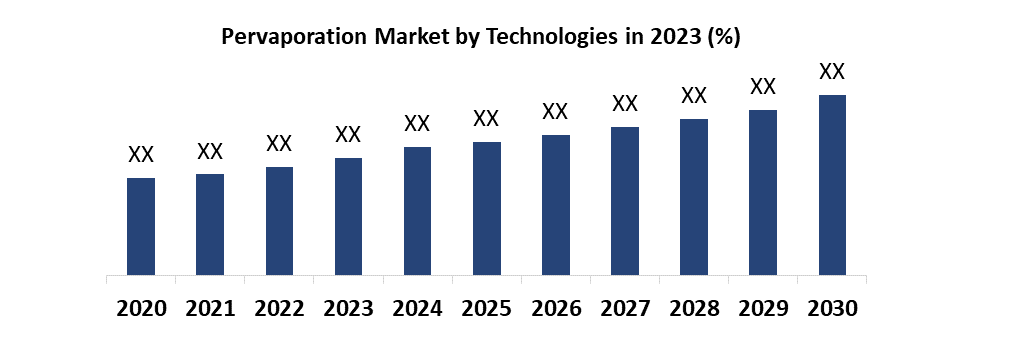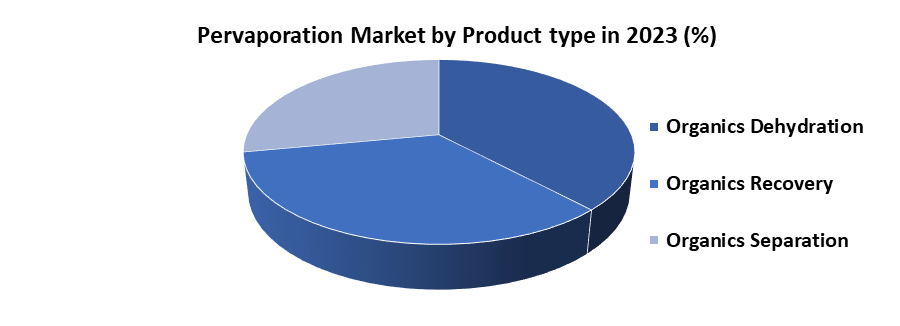Pervaporation Market: Global Industry Analysis and Forecast (2024-2030)
The Pervaporation Market size was valued at USD 2.25 Bn. in 2023 and the total Pervaporation Market size is expected to grow at a CAGR of 6.5% from 2024 to 2030, reaching nearly USD 3.50 Bn. by 2030.
Format : PDF | Report ID : SMR_2157
Pervaporation Market Overview
Pervaporation is a membrane technique that separates liquid mixtures by partially vaporizing them through a nonporous membrane. This process is used in various industries for purification and analysis because of its simplicity and in-line nature. The efficiency and economics of pervaporation are increased by innovations in membrane materials and technology. Research and development in membrane technology are crucial for market growth.
Industries such as food and beverage, pharmaceutical, petrochemical, and wastewater treatment use evaporated materials. Market growth for pervaporation is aided by the growing need for effective separation techniques. Pervaporation is considered a green technology because of its potential to use less energy than conventional separation techniques. The growing public interest in ecologically friendly and sustainable practices also drives the industry.
To get more Insights: Request Free Sample Report
Pervaporation Market Dynamics:
Pervaporation processes have become increasingly promising separation technologies for azeotropic or close boiling point mixtures because of their high separation efficiency, lower energy consumption, small footprint, environmental benignity, and flexible process control. Membranes play a crucial role in these processes, and developing appropriate membranes with high productivity, selectivity, and long-term stability is essential for their competitiveness. This thesis focuses on designing and fabricating polymer-based membranes for alcohol dehydration via pervaporation processes.
As energy demand and oil depletion increase fuel prices globally, research and development are focused on alternative fuel alternatives, such as ethanol, produced from renewable resources like molasses. Ethanol is produced from biomass, such as molasses, which are fermented and separated from water using pervaporation membrane technology. This study aims to model and simulate permeable evaporation membrane units for ethanol-water mixture separation under different operating conditions. Results include membrane selectivity, partial pressure of water and ethanol, separation factor of permeable evaporation, membrane, and feed flux. Most parameters are affected by changes in inlet temperature and concentration of the mixture.

The pervaporation market faces several difficulties, including high initial capital investment, high operational costs, limited scalability and efficiency for large-scale industrial applications, and the diversity of membrane materials and performance variability across different applications. These factors deter potential users and hinder market penetration. Also, regulatory barriers and the need for extensive testing and validation contribute to slower market penetration. To overcome these challenges, advancements in membrane technology, cost reduction strategies, and broader industry acceptance of pervaporation as a viable separation technique are needed.
Investment opportunities in the pervaporation sector are gaining attention because of the increasing demand for efficient separation technologies in numerous industries. Pervaporation presents a promising explanation for liquid separation methods, offering sustainability and resource optimization. Investors are discovering investment possibilities in research and improvement projects to decorate the efficiency and scalability of pervaporation structures. Supporting the commercialization of modern pervaporation technologies in sectors like food and beverage, prescription drugs, and wastewater remedies offers strategic growth opportunities. Investing in emerging companies specializing in advanced pervaporation membranes and systems provides strategic growth and market penetration.
Pervaporation Market Segment Analysis:
Based on Product type, Organics Dehydration is a dominant segment in the pervaporation market because membrane pervaporation is a popular method for Organics Dehydration fermentation products, particularly after primary distillation. Mass transport through the membrane determines the composition of the product, making vapor-liquid equilibrium and azeotropic effect irrelevant. Membrane pervaporation is particularly effective for separations that are difficult to achieve via thermodynamic equilibrium processes, such as distillation.
Recent references to the dehydration of ethanol include hydrophilic and lon-exchange polymer materials, with polyvinyl alcohol (PVA) family membranes being the predominant commercial membranes. Lon-exchange membranes have also been used. The driving force for transport in dehydration is chemical potential, which needs to be at least an order of magnitude to exhibit enough flux for an economical process.

Pervaporation Market Regional Insight:
The North American Pervaporation market is expected to dominate because of the increasing focus on energy efficiency and sustainability in North American businesses. Evaporated petroleum offers a more energy-efficient alternative to traditional distillation. Emerging markets, such as the US and Canada, are driving the adoption of pervaporation technology in sectors like food and beverage, pharmaceuticals, and wastewater treatment. The growing awareness of its benefits in terms of energy efficiency, selectivity, and waste reduction is driving its uptake in these emerging markets.

Pervaporation Market Competitive Landscape:
- November 17, 2022, Sulzer has successfully finalized an extensive modernization project in the Kotka pump factory. The automation and digitization of the processes are taking production to a completely new level, cutting production throughput time by 93%.
- June 7, 2024, Evonik, one of the world’s leading specialty chemicals companies, has started the production of ultra-high purity colloidal silica for the semiconductor industry at its new facility in Weston, Michigan. Colloidal silica is a critical raw material for the electronics and semiconductor industries, whose growth is driven by a surging global demand for complex and increasingly smaller microchips and digital products. The plant is the first of its kind in North America.
|
Pervaporation Market Scope |
|
|
Market Size in 2023 |
USD 2.25 Bn. |
|
Market Size in 2030 |
USD 3.50 Bn. |
|
CAGR (2024-2030) |
6.5 % |
|
Historic Data |
2018-2022 |
|
Base Year |
2023 |
|
Forecast Period |
2024-2030 |
|
Segments |
By Application Organic Pervaporation Membranes Inorganic Pervaporation Membranes |
|
By Product type Organics Dehydration Organics Recovery Organics Separation |
|
|
Regional Scope |
North America- United States, Canada, and Mexico Europe – UK, France, Germany, Italy, Spain, Sweden, Russia, and Rest of Europe Asia Pacific – China, India, Japan, South Korea, Australia, ASEAN, Rest of APAC Middle East and Africa - South Africa, GCC, Egypt, Rest of the Middle East and Africa South America – Brazil, Argentina, Rest of South America |
Key Player in the Pervaporation Market
- Pervatech BV - Netherlands
- BORSIG GmbH - Germany
- GMM Pfaudler - India
- Secoya Technologies - United States
- Sulzer - Switzerland
- Dupont - United States
- MegaVision Membrane - China
- JIUWU HI-TECH - China
- Mitsubishi Chemical Corporation - Japan
- Petro Sep - United States
- XX.inc
Frequently Asked Questions
North America is expected to lead the Pervaporation Market during the forecast period.
An analysis of profit trends and projections for companies in the Pervaporation Market is included, offering insights into factors driving profitability, cost management strategies, and financial performance metrics.
The Pervaporation Market size was valued at USD 2.25 Billion in 2023 and the total Pervaporation Market size is expected to grow at a CAGR of 6.5% from 2024 to 2030, reaching nearly USD 3.50 Billion by 2030.
The segments covered in the market report are by Application and by Product type.
1. Pervaporation Market: Research Methodology
2. Pervaporation Market: Executive Summary
3. Pervaporation Market: Competitive Landscape
4. Potential Areas for Investment
4.1. Stellar Competition Matrix
4.2. Competitive Landscape
4.3. Key Players Benchmarking
4.4. Market Structure
4.4.1. Market Leaders
4.4.2. Market Followers
4.4.3. Emerging Players
4.5. Consolidation of the Market
4.6. Import and export of Pervaporation Market
5. Pervaporation Market : Dynamics
5.1. Market Driver
5.1.1. Increasing Consumer Awareness
5.1.2. Innovation in Product Offerings
5.2. Market Trends by Region
5.2.1. North America
5.2.2. Europe
5.2.3. Asia Pacific
5.2.4. Middle East and Africa
5.2.5. South America
5.3. Market Drivers by Region
5.3.1. North America
5.3.2. Europe
5.3.3. Asia Pacific
5.3.4. Middle East and Africa
5.3.5. South America
5.4. Market Restraints
5.5. Market Opportunities
5.6. Market Challenges
5.7. PORTER’s Five Forces Analysis
5.8. PESTLE Analysis
5.9. Strategies for New Entrants to Penetrate the Market
5.10. Regulatory Landscape by Region
5.10.1. North America
5.10.2. Europe
5.10.3. Asia Pacific
5.10.4. Middle East and Africa
5.10.5. South America
6. Pervaporation Market Size and Forecast by Segments (by value Units)
6.1. Pervaporation Market Size and Forecast, by Application (2023-2030)
6.1.1. Organic Pervaporation Membranes
6.1.2. Inorganic Pervaporation Membranes
6.2. Pervaporation Market Size and Forecast, by Product type (2023-2030)
6.2.1. Organics Dehydration
6.2.2. Organics Recovery
6.2.3. Organics Separation
6.3. Pervaporation Market Size and Forecast, by Region (2023-2030)
6.3.1. North America
6.3.2. Europe
6.3.3. Asia Pacific
6.3.4. Middle East and Africa
6.3.5. South America
7. North America Pervaporation Market Size and Forecast (by value Units)
7.1. North America Pervaporation Market Size and Forecast, by Application (2023-2030)
7.1.1. Organic Pervaporation Membranes
7.1.2. Inorganic Pervaporation Membranes
7.2. North America Pervaporation Market Size and Forecast, by Product type (2023-2030)
7.2.1. Organics Dehydration
7.2.2. Organics Recovery
7.2.3. Organics Separation
7.3. North America Pervaporation Market Size and Forecast, by Country (2023-2030)
7.3.1. United States
7.3.2. Canada
7.3.3. Mexico
8. Europe Pervaporation Market Size and Forecast (by Value Units)
8.1. Europe Pervaporation Market Size and Forecast, by Application (2023-2030)
8.1.1. Organic Pervaporation Membranes
8.1.2. Inorganic Pervaporation Membranes
8.2. Europe Pervaporation Market Size and Forecast, by Product type (2023-2030)
8.2.1. Organics Dehydration
8.2.2. Organics Recovery
8.2.3. Organics Separation
8.3. Europe Pervaporation Market Size and Forecast, by Country (2023-2030)
8.3.1. UK
8.3.2. France
8.3.3. Germany
8.3.4. Italy
8.3.5. Spain
8.3.6. Sweden
8.3.7. Austria
8.3.8. Rest of Europe
9. Asia Pacific Pervaporation Market Size and Forecast (by Value Units)
9.1. Asia Pacific Pervaporation Market Size and Forecast, by Application (2023-2030)
9.1.1. Organic Pervaporation Membranes
9.1.2. Inorganic Pervaporation Membranes
9.2. Asia Pacific Pervaporation Market Size and Forecast, by Product type (2023-2030)
9.2.1. Organics Dehydration
9.2.2. Organics Recovery
9.2.3. Organics Separation
9.3. Asia Pacific Pervaporation Market Size and Forecast, by Country (2023-2030)
9.3.1. China
9.3.2. S Korea
9.3.3. Japan
9.3.4. India
9.3.5. Australia
9.3.6. Asean
9.3.7. Rest of Asia Pacific
10. Middle East and Africa Pervaporation Market Size and Forecast (by Value Units)
10.1. Middle East and Africa Pervaporation Market Size and Forecast, by Application (2023-2030)
10.1.1. Organic Pervaporation Membranes
10.1.2. Inorganic Pervaporation Membranes
10.2. Middle East and Africa Pervaporation Market Size and Forecast, by Product type (2023-2030)
10.2.1. Organics Dehydration
10.2.2. Organics Recovery
10.2.3. Organics Separation
10.3. Middle East and Africa Pervaporation Market Size and Forecast, by Country (2023-2030)
10.3.1. South Africa
10.3.2. GCC
10.3.3. Rest of ME&A
11. South America Pervaporation Market Size and Forecast (by Value Units)
11.1. South America Pervaporation Market Size and Forecast, by Application (2023-2030)
11.1.1. Organic Pervaporation Membranes
11.1.2. Inorganic Pervaporation Membranes
11.2. South America Pervaporation Market Size and Forecast, by Product type (2023-2030)
11.2.1. Organics Dehydration
11.2.2. Organics Recovery
11.2.3. Organics Separation
11.3. South America Pervaporation Market Size and Forecast, by Country (2023-2030)
11.3.1. Brazil
11.3.2. Argentina
11.3.3. Rest of South America
12. Company Profile: Key players
12.1. Pervatech BV
12.1.1. Company Overview
12.1.2. Financial Overview
12.1.3. Business Portfolio
12.1.4. SWOT Analysis
12.1.5. Business Strategy
12.1.6. Recent Developments
12.2. BORSIG GmbH
12.3. GMM Pfaudler
12.4. Secoya Technologies
12.5. Sulzer
12.6. Dupont
12.7. MegaVision Membrance
12.8. JIUWU HI-TECH
12.9. Mitsubishi Chemical Corporation
12.10. Petro Sep
12.11. XX.inc
13. Key Findings
14. Industry Recommendation
















